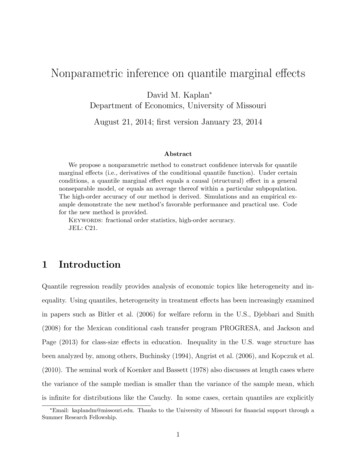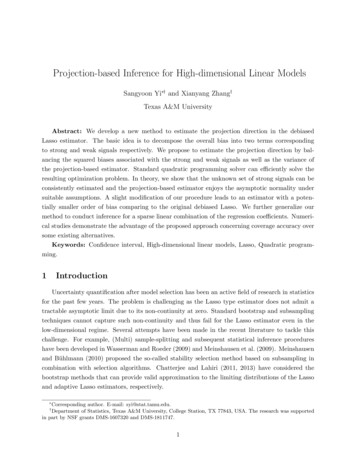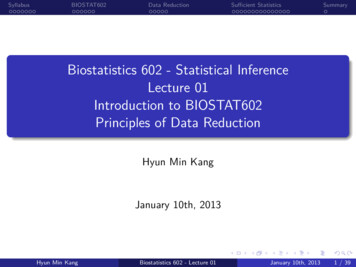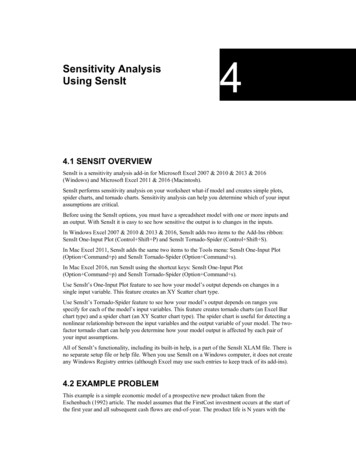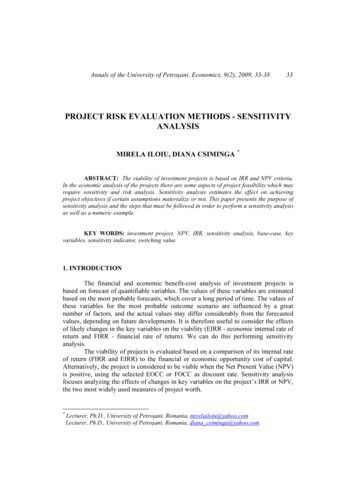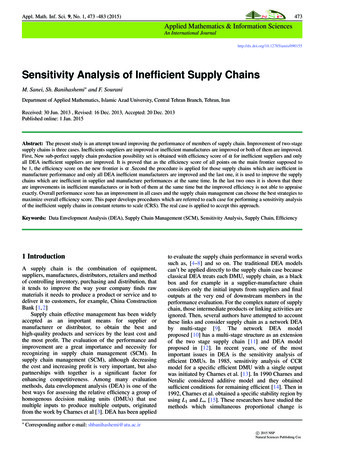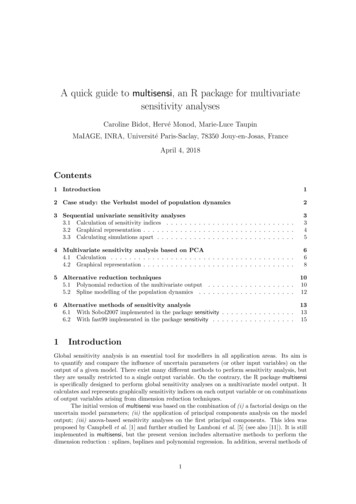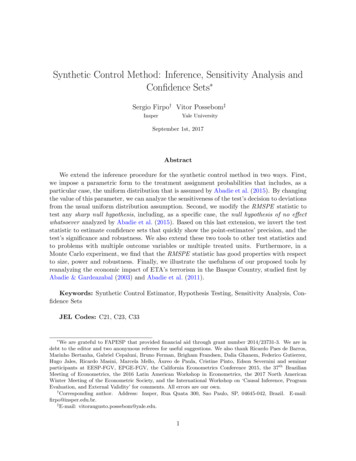
Transcription
Synthetic Control Method: Inference, Sensitivity Analysis andConfidence Sets Sergio Firpo† Vitor Possebom‡InsperYale UniversitySeptember 1st, 2017AbstractWe extend the inference procedure for the synthetic control method in two ways. First,we impose a parametric form to the treatment assignment probabilities that includes, as aparticular case, the uniform distribution that is assumed by Abadie et al. (2015). By changingthe value of this parameter, we can analyze the sensitiveness of the test’s decision to deviationsfrom the usual uniform distribution assumption. Second, we modify the RMSPE statistic totest any sharp null hypothesis, including, as a specific case, the null hypothesis of no effectwhatsoever analyzed by Abadie et al. (2015). Based on this last extension, we invert the teststatistic to estimate confidence sets that quickly show the point-estimates’ precision, and thetest’s significance and robustness. We also extend these two tools to other test statistics andto problems with multiple outcome variables or multiple treated units. Furthermore, in aMonte Carlo experiment, we find that the RMSPE statistic has good properties with respectto size, power and robustness. Finally, we illustrate the usefulness of our proposed tools byreanalyzing the economic impact of ETA’s terrorism in the Basque Country, studied first byAbadie & Gardeazabal (2003) and Abadie et al. (2011).Keywords: Synthetic Control Estimator, Hypothesis Testing, Sensitivity Analysis, Confidence SetsJEL Codes: C21, C23, C33 We are grateful to FAPESP that provided financial aid through grant number 2014/23731-3. We are indebt to the editor and two anonymous referees for useful suggestions. We also thank Ricardo Paes de Barros,Marinho Bertanha, Gabriel Cepaluni, Bruno Ferman, Brigham Frandsen, Dalia Ghanem, Federico Gutierrez,Hugo Jales, Ricardo Masini, Marcela Mello, Áureo de Paula, Cristine Pinto, Edson Severnini and seminarparticipants at EESP-FGV, EPGE-FGV, the California Econometrics Conference 2015, the 37th BrazilianMeeting of Econometrics, the 2016 Latin American Workshop in Econometrics, the 2017 North AmericanWinter Meeting of the Econometric Society, and the International Workshop on ‘Causal Inference, ProgramEvaluation, and External Validity’ for comments. All errors are our own.†Corresponding author. Address: Insper, Rua Quata 300, Sao Paulo, SP, 04645-042, Brazil. E-mail:firpo@insper.edu.br.‡E-mail: vitoraugusto.possebom@yale.edu.1
1IntroductionThe Synthetic Control Method (SCM) was proposed by Abadie & Gardeazabal (2003),Abadie et al. (2010) and Abadie et al. (2015) to address counterfactual questions involvingonly one treated unit and a few control units. Intuitively, this method constructs a weightedaverage of control units that is as similar as possible to the treated unit regarding the pretreatment outcome variable and covariates. For this reason, this weighted average of controlunits is known as the synthetic control. Since the empirical literature applying SCM is vast,1developing and expanding this tool’s theoretical foundation is an important task.The inference procedure for small samples using the synthetic control estimator was developed by Abadie et al. (2010) and Abadie et al. (2015). Using placebo tests similar to Fisher’sExact Hypothesis Testing Procedure described by Fisher (1971), Imbens & Rubin (2015) andRosenbaum (2002), they compare an observed test statistic to its empirical distribution inorder to verify whether there is enough evidence to reject the null hypothesis of no effectwhatsoever. We extend this inference procedure in two ways.First, we stress that the p-value proposed by Abadie et al. (2015) implicitly assumes thatthe treatment assignment probabilities are the same across all units, i.e., any observed regionhas the same probability of facing the analyzed intervention. By making this assumptionclear, we can address the robustness of the decision based on the hypothesis test to alternativetreatment assignment distributions by applying a sensitivity analysis mechanism similar to theone proposed by Rosenbaum (2002) and Cattaneo et al. (2016). We impose a parametric formto the treatment assignment probabilities that allows the empirical researcher to computep-values for different assumptions regarding these probabilities. As we change the value1This tool was applied to an extremely diverse set of topics, including, for instance, issues related toterrorism, civil wars and political risk (Abadie & Gardeazabal (2003), Bove et al. (2014), Li (2012), Montalvo(2011), Yu & Wang (2013)), natural resources and disasters (Barone & Mocetti (2014), Cavallo et al. (2013),Coffman & Noy (2011), DuPont & Noy (2012), Mideksa (2013), Sills et al. (2015), Smith (2015)), internationalfinance (Jinjarak et al. (2013), Sanso-Navarro (2011)), education and research policy (Belot & Vandenberghe(2014), Chan et al. (2014), Hinrichs (2012)), health policy (Bauhoff (2014), Kreif et al. (2015)), economicand trade liberalization (Billmeier & Nannicini (2013), Gathani et al. (2013), Hosny (2012)), political reforms(Billmeier & Nannicini (2009), Carrasco et al. (2014), Dhungana (2011) Ribeiro et al. (2013)), labor (Bohnet al. (2014), Calderon (2014)), taxation (Kleven et al. (2013), de Souza (2014)), crime (Pinotti (2012b), Pinotti(2012a), Saunders et al. (2014)), social connections (Acemoglu et al. (2013)), and local development (Ando(2015), Gobillon & Magnac (2016), Kirkpatrick & Bennear (2014), Liu (2015), Possebom (2017) and Severnini(2014)).2
of the parameter that affects the decision based on the hypothesis test, we can gauge thesensitiveness of the decision made to the usual assumption of an uniform distribution oftreatment assignment probabilities. We also highlight that the results of this sensitivityanalysis mechanism can easily be displayed in a graph that quickly shows the robustness ofthe decision based on the test.Second, Abadie et al. (2010) and Abadie et al. (2015) only test the null hypothesis ofno effect whatsoever, which is the most common null hypothesis of interest in the empiricalliterature, albeit restrictive. We extend their inference procedure to test any kind of sharp nullhypothesis. This possibility is relevant in order to approximate the intervention effect functionby simpler functions that can be used to predict its future behavior. Most importantly, beingable to test more flexible null hypotheses is fundamental to compare the costs and benefits ofa policy. For example, one can interpret the intervention effect as the policy’s benefit and testwhether it is different from its costs. It also enables the empirical researcher to test theoriesrelated to the analyzed phenomenon, particularly the ones that predict some specific kind ofintervention effect.Based on this extension of the current existing inference procedure, we propose a methodto compute confidence sets by inverting a test statistic. We modify the method describedby Imbens & Rubin (2015) and Rosenbaum (2002) to calculate confidence intervals basedon Fisher’s Exact Hypothesis Testing Procedure and apply it to SCM. To the best of ourknowledge, this is the first work to propose confidence sets for the intervention effect functionusing SCM when its typical setup is prevailing. That is, when we observe aggregate level datafor only one treated unit and few control units (i.e., small finite samples) in a context whosecross-section dimension may be larger than its time dimension. Although the assumptionsthat make them valid are strong, our confidence sets allow the researcher to quickly andvisually show, not only the significance of the estimated intervention effect in a given pointin time, but also the precision of the point estimates. This plot summarizes a large amountof information that is important to measure the strength of qualitative conclusions achievedafter an econometric analysis. Furthermore, these confidence set plots can easily be combined3
with the aforementioned sensitivity analysis mechanism to quickly display the robustness ofthe empirical findings.We then extend the inference method developed by Abadie et al. (2010) and Abadie et al.(2015) to use many different test statistics beyond the already traditional Ratio of the MeanSquared Prediction Errors (RMPSE ) test statistic, discussed in those papers. We run aMonte Carlo experiment and present results on size, power and our robustness analysis offive test statistics applied to SCM. We choose these test statistics based on our review of theempirical literature that applies the method. More specifically, we compare test statistics thatuse SCM to test statistics typically used in other methods (e.g. difference in means and apermuted differences-in-differences test that are commonly used in the evaluation literature)and to the asymptotic inference procedure for the difference-in-differences estimator proposedby Conley & Taber (2011). We find that the inference procedure based on the original teststatistic proposed by Abadie et al. (2015), RMPSE, performs much better than alternativetest statistics when we compare their size, power and in our sensitivity analysis.We also show how to apply our new tools to contexts that differ from the ones analyzedby Abadie & Gardeazabal (2003), Abadie et al. (2010) and Abadie et al. (2015) in importantdimensions. A researcher that wants to test null hypotheses about a pooled effect among fewtreated units, as studied by Cavallo et al. (2013), can apply our sensitivity analysis mechanism,test any sharp null hypothesis and compute our confidence sets too. Moreover, a researcherwho wants to simultaneously test null hypotheses for different outcome variables can applyour sensitivity analysis mechanism and test any sharp null hypothesis. This last extension,that expands the multiple hypotheses framework described by Anderson (2008) to SCM, isimportant, for example, to evaluate political reforms (Billmeier & Nannicini (2009), Billmeier& Nannicini (2013), Carrasco et al. (2014), Jinjarak et al. (2013), Sanso-Navarro (2011))that generally affect multiple outcomes variables, such as income levels and investment rates.Moreover, we can also interpret each post-intervention time period as a different outcomevariable, allowing us to investigate the timing of an intervention effect, a relevant possibilitywhen the empirical researcher aims to uncover short and long term effects.4
At the end, we apply the inference procedure proposed by Abadie et al. (2010) and Abadieet al. (2015), its associated sensitivity analysis, its extension to other sharp null hypotheses,its associated confidence sets and its extension to the case of simultaneous hypothesis testingto reevaluate the economic impact of ETA’s terrorism estimated by Abadie & Gardeazabal(2003) and Abadie et al. (2011). With this empirical exercise, we illustrate how our sensitivityanalysis mechanism and our proposed confidence sets summarize a large amount of informationin simple graphs. Our sensitivity analysis mechanism also shows that Abadie & Gardeazabal(2003) and Abadie et al. (2011) reach very robust conclusions about the economic impact ofETA’s terrorism on the Basque Country.Literature ReviewRegarding the inference of the Synthetic Control Method, other authors have surely madeimportant previous contributions. Abadie et al. (2010)2 are the first authors to proposea inference procedure that consists in estimating p-values through permutation tests andAbadie et al. (2015) suggest a different test statistic for the same procedure. Ando & Sävje(2013) propose two new test statistics that have adequate size and more power when appliedto the above mentioned hypothesis test than the ones proposed by Abadie et al. (2010) andAbadie et al. (2015).Bauhoff (2014), Calderon (2014) and Severnini (2014) propose a way to apply SCM tomany treated and control units that is similar to a matching estimator for panel data. Following a similar approach, Wong (2015) extends the synthetic control estimator to a crosssectional setting where individual-level data is available and derives its asymptotic distribution when the number of observed individuals goes to infinity. Wong (2015) also exploresthe synthetic control estimator when panel data (or repeated cross-sections) are available intwo levels: an aggregate level (regions), where treatment is assigned, and an individual level,where outcomes are observed. In this framework, he derives the asymptotic distribution ofthe synthetic control estimator when the number of individuals in each region goes to infinity.2They also discuss the asymptotic unbiasedness of their method. Kaul et al. (2015) deepen this topic byarguing that using all pre-intervention outcomes as economic predictors might provoke bias by forcing thesynthetic control estimator to ignore all other predictor covariates.5
Finally, Acemoglu et al. (2013), Cavallo et al. (2013) and Dube & Zipperer (2013) developdifferent ways to apply SCM when there are more than one treated unit and propose teststhat are similar to the ones proposed by Abadie et al. (2010) and Abadie et al. (2015).Gobillon & Magnac (2016), also working in a context with more than one treated unit,propose a way to compute confidence intervals for policy effect function based on the bootstrap. Their procedure requires a large number of treated and control regions in order to bevalid and focuses exclusively on the time average of the post-intervention effect. Our approachdiffers from theirs in two ways: it is valid in small samples and allows the construction ofconfidence sets for the post-intervention effect as a function of time. Consequently, while theirinference procedure allows testing a constant (over time) policy effect only, our extension ofthe inference procedure developed by Abadie et al. (2010) and Abadie et al. (2015) allows theempirical researcher to test any function of time as the intervention effect.Moreover, Carvalho et al. (2015) propose the Artificial Counterfactual Estimator (ArCo),that is similar in purpose to SCM, and derive its asymptotic distribution when the timedimension is large (long panel data sets). However, many of the problems to which theSCM is applied present a cross-section dimension larger than their time dimension, making itimpossible to apply Carvalho et al. (2015)’s method.3Our approach is similar to the way Conley & Taber (2011) estimate confidence intervalsfor the difference-in-differences estimator in the sense that we also construct confidence setsby inverting a test statistic. However, we differ from them in many aspects. Firstly, while theymake a contribution to the difference-in-differences framework, our contribution is inserted inthe Synthetic Control literature. Secondly, they assume a functional form for the potentialoutcomes — imposing that the treatment effect is constant in time — and an arbitrarily largenumber of control units, while we assume a fixed and (possibly) small number of control unitsand make no assumptions concerning the potential outcome functional form — i.e., treatmenteffects can vary in time.Finally, the sensitivity analysis literature in a context of observational studies is vast. For3Wong (2015) and Hahn & Shi (2016) also conduct an asymptotic analysis when the pre-intervention periodgoes to infinity. Ferman & Pinto (2017b), Ferman & Pinto (2017a) and Ferman et al. (2017) discuss asymptoticbiases, size distortions and specification-search possibilities within SCM.6
example, Rosenbaum (1987), Rosenbaum (1988), Rosenbaum & Krieger (1990), Rosenbaum(2002), Rosenbaum (2007), and Rosenbaum & Silber (2009) made important contributions tothis field, particularly with respect to matching estimators. Cattaneo et al. (2016) exemplifyone way to apply similar tools to a regression discontinuity design. We contribute to thisliterature by applying a standard sensitivity analysis mechanism to the synthetic controlestimator.This paper is divided as follows. Section 2 formally presents SCM as proposed by Abadie& Gardeazabal (2003), Abadie et al. (2010) and Abadie et al. (2015). Section 3 proposes a sensitivity analysis related to the assumption of a uniform distribution of treatment assignmentprobabilities. In Section 4 we extend the inference procedure to test any sharp null hypothesisand propose a way to construct confidence sets for the policy effect function. In Section 5, werun a Monte Carlo experiment to analyze the size, the power and the robustness of differenttests statistics. We then extend the sensitivity analysis mechanism and the confidence setsto the cases when we observe multiple treated units or multiple outcomes in Section 6. Werevisit, using the methods here developed, the empirical application on the Basque Countryused by Abadie et al. (2011) in Section 7. Finally, section 8 concludes.2Synthetic Control MethodThis section is organized in two subsections. The first one presents the Synthetic ControlMethod, while the second one explains its inference procedure based on permutation tests.The ideas and notation that are used in the next two subsections are mostly based on Abadieet al. (2010) and Abadie et al. (2015). We present these two topics in a way that will helpus explain our sensitivity analysis mechanism, our extension to test any sharp null hypothesisusing any test statistic and our confidence sets.7
2.1SCM: Policy Effect and EstimationSuppose that we observe data for (J 1) N regions4 during T N time periods.Additionally, assume that there is an intervention (policy)5 that affects only region 16 fromN be theperiod T0 1 to period T uninterruptedly7 , where T0 (1, T ) N. Let the scalar Yj,tpotential outcome that would be observed for region j in period t if there were no interventionI be the potential outcome that wouldfor j {1, ., J 1} and t {1, ., T }. Let the scalar Yj,tbe observed for region j in period t if region j faced the intervention at period t. DefineINαj,t : Yj,t Yj,t(1)as the intervention (policy) effect (sometimes simply called the gap) for region j in periodt and Dj,t as a dummy variable that assumes value 1 if region j faces the intervention in periodt and value 0 otherwise. With this notation, we have that the observed outcome for unit jN α D . Since only the first region faces the interventionin period t is given by Yj,t : Yj,tj,t j,tfrom period T0 1 to T , we have that Dj,t : 1 if j 1 and t T0 , and Dj,t : 0 otherwise.I is observable for t T , equation (1)We aim to estimate (α1,T0 1 , ., α1,T ). Since Y1,t0N to accomplish this goal.guarantees that we only need to estimate Y1,tLet Yj : [Yj,1 .Yj,T0 ]0 be the vector of observed outcomes for region j {1, ., J 1} in thepre-intervention period and Xj a (K 1)-vector of predictors of Yj .8 Let Y0 [Y2 .YJ 1 ]be a (T0 J)-matrix and X0 [X2 .XJ 1 ] be a (K J)-matrix.4We use the word “region” instead of more generic terms, such as “unit”, because most synthetic controlapplications analyze data that are aggregated at the state or country level. We use the term donor pool todesignated the entire group of (J 1) observed regions.5Although the treatment effect literature commonly uses the more generic expression “treated unit”, weadopt the expression “the region that faced an intervention” because it is more common in the comparativepolitics literature, an area where the synthetic control method is largely applied.6In subsection 6.2, we extend this framework to include the case when multiple units face the same or asimilar intervention.7Two famous examples of interventions that affect uninterruptedly a region are Proposition 99 — an TobaccoControl Legislation in California — and the German Reunification, that were studied by Abadie et al. (2010)and Abadie et al. (2015), respectively. If the intervention is interrupted (e.g.: ETA’s Terrorism in the BasqueCountry studied by Abadie & Gardeazabal (2003)), we just have to interpret our treatment differently. Insteadof defining the treatment as “region 1 faces an intervention”, we define treatment as “region 1 have been exposedto an event that potentially has long term consequences”. For example, instead of defining our treatment as“the Basque Country faces constant bombings perpetrated by ETA”, we define our treatment as “the BasqueCountry suffered some bombings perpetrated by ETA”.8Some lines of matrix Xj can be linear combinations of the variables in Yj .8
Since we want to make region 1’s synthetic control as similar as possible to the actualPJ 1N : region 1, SCM produces, for each t {1, ., T }, Yb1,tbj Yj,t , which is an estimator ofj 2 wN . The weights are given by Wc [wc V)b RJ , which are the solution to aY1,tb2 .wbJ 1 ]0 : W(nested minimization problem:cW(V): arg min (X1 X0 W)0 V(X1 X0 W)W W(2)noPJ 1where W : W [w2 .wJ 1 ]0 RJ : wj 0 for each j {2, ., J 1} andw 1j 2 jand V is a diagonal positive semidefinite matrix of dimension (K K) whose trace equalsone. Moreover,0b : arg min (Y1 Y0 W(V))ccV(Y1 Y0 W(V))V V(3)where V is the set of diagonal positive semidefinite matrix of dimension (K K) whose traceequals one.c is a weighting vector that measures the relative importance of each regionIntuitively, Wb measures the relative importance of each one of thein the synthetic control of region 1 and VK predictors. Consequently, this technique makes the synthetic control of region 1 as similaras possible to the actual region 1 considering the K predictors and the pre-intervention valuesof the outcome variable when we choose the Euclidean metric (or a reweighed version of it)to evaluate the distance between the observed variables for region 1 and the values predictedby SCM.9Finally, we define the synthetic control estimator of α1,t (or the estimated gap) as αb1,t : 9Abadie & Gardeazabal (2003), Abadie et al. (2010) and Abadie et al. (2015) propose two other waysb The first and most simple one is to use subjective and previous knowledge about the relativeto choose V.importance of each predictor. Since one of the advantages of SCM is to make the choice of comparison groups incomparative case studies more objective, this method of choosing V is discouraged by those authors. Anotherb is to divide the pre-intervention period in two sub-periods: one training period and onechoice method for Vvalidation period. While data from the training period are used to solve problem (2), data for the validationc V)b toperiod are used to solve problem (3). Intuitively, this technique of cross-validation chooses matrix W(minimize the out-of-sample prediction errors, an advantage when compared to the method described in themain text. However, the cost of this improvement is the need of a longer pre-intervention period. Moreover, theStata command made available by those authors also allows the researcher to use a regression-basedmethodin b It basically regress matrix Y1 on X1 and imposes vk βk / PK0 βk0 , whereorder to compute matrix V.k 1vk is the k-th diagonal element of matrix V and βk is the k-th coefficient of the regression of Y1 on X1 . Thechoice method that we have chosen to present in the main text is the most used one in the empirical literature.9
N for each t {1, ., T }.Y1,t Yb1,t2.2Hypothesis TestingAbadie et al. (2010) and Abadie et al. (2015) develop a small sample inference procedurefor SCM that is similar to Fisher’s Exact Hypothesis Test described by Fisher (1971), Imbens& Rubin (2015) and Rosenbaum (2002). Abadie et al. (2010) permute regions to the treatmentand estimate, for each j {2, ., J 1} and t {1, ., T }, αbj,t as described in subsection 2.1.b 1 [bThen, they compare the entire vector αα1,T0 1 .bα1,T ]0 with the empirical distribution ofb j [bααj,T0 1 .bαj,T ]0 estimated through the permutation procedure. If the vector of estimatedeffects for region 1 is very different (i.e., large in absolute values), they reject the null hypothesisof no effect whatsoever.10Abadie et al. (2015) highlight that bα1,t can be abnormally large when compared to theempirical distribution of bαj,t for some t {T0 1, ., T }, but not for other time periods. Inthis case, it is not clear at all whether one should reject the null hypothesis of no effect ornot. In order to solve this problem, they recommend to use the empirical distribution of asummary statistic:PTRM SP Ej : 2dN/(T T0 )Yj,t Yj,t, 2PT0dN/T0t 1 Yj,t Yj,t t T0 1(4)Moreover, they propose to calculate a p-valuePJ 1p : j 1I [RM SP Ej RM SP E1 ]J 1,(5)where I[A] is the indicator function of event A, and reject the null hypothesis of no effectwhatsoever if p is less than some pre-specified significance level, such as the traditional valueof γ 0.1.As Abadie et al. (2010) and Abadie et al. (2015) make clear, this inference procedure10As an anonymous referee pointed out, Abadie et al. (2010) and Abadie et al. (2015) exclude the treatedunit from the donor pool of the placebo runs in order to avoid bias when there is a treatment effect. Here,we follow Imbens & Rubin (2015) and keep the treated unit in the donor pool of the placebo runs, because,under sharp null hypotheses, the treatment effect is known. In our empirical application, we show that ourconclusions do not change whether we follow the suggestions by Imbens & Rubin (2015) or by Abadie et al.(2010) and Abadie et al. (2015).10
is valid under three assumptions. First, we need to impose the stable unit treatment valueassumption (SUTVA):hhi0i0I .Y IN : Y N .Y NAssumption 1 The potential outcome vectors YjI : Yj,1andYjj,1j,Tj,Tfor each region j {1, ., J 1} do not vary based on whether other regions face the intervention or not (i.e., no spill-over effects in space) and, for each region, there are no differentforms or versions of intervention (i.e., single dose treatment), which lead to different potentialoutcomes (Imbens & Rubin 2015, p. 19).Second, we need to impose some form of random assignment to the treatment:Assumption 2 The choice of which unit will be treated (i.e., which region is our region 1)is random conditional on the choice of the donor pool, the observable variables included aspredictors and the unobservable variables captured by the path of the outcome variable duringthe pre-intervention period.11Assumption 2 is closely related to the literature about selection on unobservables. Theanalogous assumption for the difference-in-differences estimator would be (Assumption DID)“The choice of which unit will be treated (i.e., which region is our region 1) is random conditional on the choice of the donor pool, the observable variables included as control variablesand the unobservables variables that are common among all the observed units (but variesover time)”.Since the differences-in-differences estimator controls only for the unobservable variablesthat are common among all the observed units (but varies over time) while the syntheticcontrol estimator controls for unobservable variables captured by the path of the outcomevariable during the pre-intervention period, assumption 2 is weaker than assumption DID.12Regarding the applicability of assumption 2, it holds true for many empirical applicationsof the synthetic control estimator. For example, Barone & Mocetti (2014), Cavallo et al.(2013), Coffman & Noy (2011) and DuPont & Noy (2012) evaluate the economic effect of11The unobservable variables captured by the path of the outcome variable during the pre-intervention periodare denoted by unobserved common factors, λt , and unknown factor loadings, µi in the factor model discussedby Abadie et al. (2010).12The differences-in-differences model is actually nested in the factor model discussed by Abadie et al. (2010).11
large scale natural disasters, such as earthquakes, hurricanes or volcano eruptions. Althoughthe regions in the globe that frequently faces these disasters are not random, the specificregion among them that will be hit by a natural disaster and the timing of this phenomenonare fully random.13 Moreover, Pinotti (2012b) and Pinotti (2012a) evaluate the economicand political cost of organized crime in Italy exploring the increase in Mafia activities aftertwo large earthquakes. Two other examples of the plausibility of assumption 2 are Smith(2015), who argues that the discovery of large natural resources reserves is as-if-random, andLiu (2015), who argues that the location of land-grand universities in the 19th century isas-if-random too.14The third assumption is related to how we interpret the potential outcomes:hi0hi0I .Y IN : Y N .Y NAssumption 3 The potential outcomes YjI : Yj,1andYfor eachjj,1j,Tj,Tregion j {1, ., J 1} are fixed but a priori unknown quantities.15Implicitly, we assume that we observe the realization of a random variable for the entirepopulation of interest instead of a random sample of a larger superpopulation.16We note that assumptions 2 and 3 implies that the units in the donor pool are exchangeable. In reality, exchangeability is the weakest assumption that guarantees the validity of thisinference procedure, because it is simply based in a permutation test.17 However, we believethat, although stronger, assumptions 2 and 3 makes interpretation easier, providing a usefulframework in order to discuss the validity of the synthetic control method in applied topics.Finally, Abadie et al. (2010) and Abadie et al. (2015) propose to test the the exact null13In this example, the donor pool contains all countries that frequently faces natural disasters. Conditionalon being in the donor pool, being treated (i.e., being hit by a natural disaster in the analyzed time window) israndom.14Even in randomized control trials, the synthetic control method may be more interesting than traditionalstatistical methods when there are only a few treated units — an issue that may emerge due to budgetconstraints. As we show in section 5, test statistics that use the synthetic co
treated units, as studied byCavallo et al.(2013), can apply our sensitivity analysis mechanism, test any sharp null hypothesis and compute our con dence sets too. Moreover, a researcher who wants to simultaneously test null hypotheses for di erent outcome variables can apply our sensitivity analysis mechanism and test any sharp null hypothesis.

